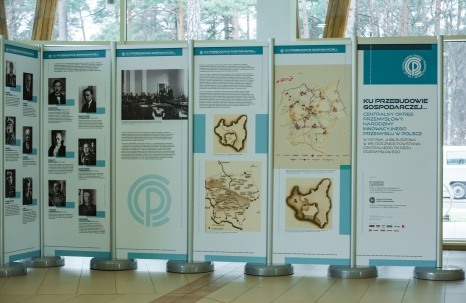
Towards economic reconstruction
from 07.07-31.12.2022
Exhibition place COP Museum, 17 Hutnicza St. Open-air exhibition
4.02-10.06.2022
Exhibition location: Faculty of Mechanics and Technology of Rzeszów University of Technology in Stalowa Wola, 4 Kwiatkowskiego St.
TOWARDS ECONOMIC RECONSTRUCTION…CENTRAL INDUSTRIAL DISTRICT. THE BIRTH OF INNOVATIVE INDUSTRY IN POLANDThe board exhibition.
85 years ago, on the southeastern outskirts of Poland, in the geographical triangle of security, the sides of which were formed by the Vistula River, the San River and the Carpathian range, the construction of a powerful industrial center began. The biggest investment challenge of the Polish interwar period – the Central Industrial District – was supposed to be an answer and a cure for the post-abduction civilizational backwardness of the Polish lands, the economic crisis and the scourge of unemployment.
Adopted by the Sejm in early 1937, the plan to build the CID made the territory in the forks of the Vistula and San rivers the largest construction site in Eastern Europe for more than two years. From March 1937 to September 1939, 45 major and medium-sized and 60 small factories were built here, providing employment for 110,000 people. The enterprises came out of the hands of Polish engineers, foremen and skilled workers arriving in the CID area from almost every corner of the country. The state-of-the-art technologies that were used to launch factories and the construction of plants with a broad spectrum of production provided the entire region with a powerful civilizational advance. The Central Industrial District became the largest modernization project of the Second Polish Republic, thanks to which the hitherto economically backward southeastern part of Poland recorded an industrial and urbanization leap. Although World War II prevented the completion of this ambitious concept, the CID still remained a far-reaching initiative, and traces of its legacy survive to this day. The project comprehensively combined issues of military security, national economic development, regional policy and the social and material advancement of a large segment of the population. He precisely delineated geographical boundaries, the economic specialization of individual regions, and clearly indicated sources of funding by establishing partnership rules for cooperation between the state and private entities. By focusing attention on modern and extremely necessary to Poland steel, chemical and armaments industries, he activated economically backward areas. Today, it is a testament to Polish technical thought, commitment and determination, a monument to the great efforts of society in the pursuit of economic, economic and social stabilization of the country and faith in Polish success.
The exhibition “Towards economic reconstruction…” was prepared on the occasion of the 85th anniversary of the approval by the Sejm of the plan for the construction of the Central Industrial District. It consists of twenty boards, which present the most important issues related to the history and heritage of the CID. The exhibition consists of archival photographs, which immortalize the builders and organizers of CID, key economic investments, urbanization works and a number of issues related to the production of CID factories and plants. The exhibition is supplemented by boards presenting the new Museum of the Central Industrial District, the opening of which will be one of the highlights of this year’s anniversary celebrations. The title of the exhibition is taken from a 1937 publication entitled. “Toward Economic Reconstruction. State Investment Guidelines,” which published a speech by Deputy Prime Minister Eugeniusz Kwiatkowski and speeches by ministers of various ministries. They were delivered on February 5, 1937, at a meeting of the Sejm’s Budget Committee approving the CID construction project.